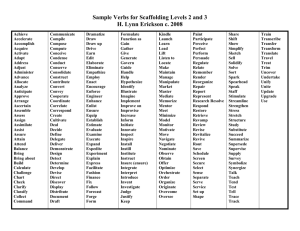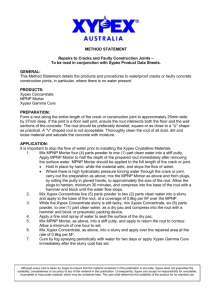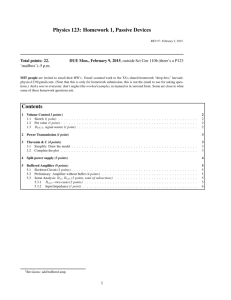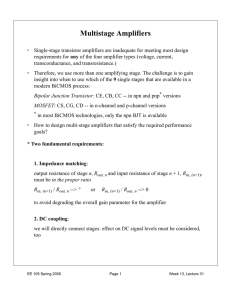CRACK SEALING, Measurement of Rout
advertisement
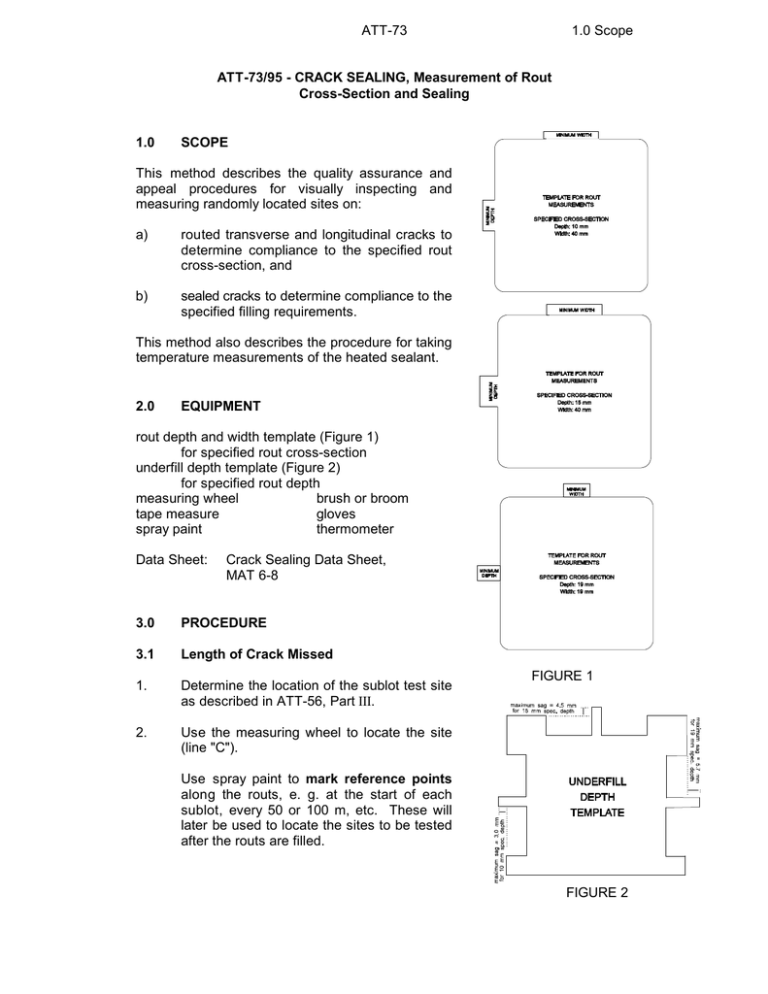
ATT-73 1.0 Scope ATT-73/95 - CRACK SEALING, Measurement of Rout Cross-Section and Sealing 1.0 SCOPE This method describes the quality assurance and appeal procedures for visually inspecting and measuring randomly located sites on: a) routed transverse and longitudinal cracks to determine compliance to the specified rout cross-section, and b) sealed cracks to determine compliance to the specified filling requirements. This method also describes the procedure for taking temperature measurements of the heated sealant. 2.0 EQUIPMENT rout depth and width template (Figure 1) for specified rout cross-section underfill depth template (Figure 2) for specified rout depth measuring wheel brush or broom tape measure gloves spray paint thermometer Data Sheet: Crack Sealing Data Sheet, MAT 6-8 3.0 PROCEDURE 3.1 Length of Crack Missed 1. Determine the location of the sublot test site as described in ATT-56, Part III. 2. Use the measuring wheel to locate the site (line "C"). FIGURE 1 Use spray paint to mark reference points along the routs, e. g. at the start of each sublot, every 50 or 100 m, etc. These will later be used to locate the sites to be tested after the routs are filled. FIGURE 2 ATT-73 3.1 Length of Rout Missed 3. After the rout is cleaned and before it is sealed, for each test site use the measuring wheel to locate the site. 4. Measure the length of the site and record it in line "D" as shown in Figure 3. A minimum of 1 m site length is specified. FIGURE 3 ATT-73 5. Measure the total length of the rout which has missed the crack. Record as Length Missed (line "E"). NOTE: 3.2 3.2 Depth and Width of Rout The Length Missed is the total length of crack whose width is not totally within the rout of the test site. Length Missed includes the length of the crack on the edge of the rout wall. Depth and Width of Rout After the "length missed" measurements, for each test site proceed as follows: 1. Lay the measuring tape on the test site parallel to the rout. 2. At the start of the test site, insert into the rout the minimum depth side of the template (for the specified depth). 3. If the sides of the template are above the edges of the rout, as shown in Figure 4-A, the rout depth is below the specified minimum depth. If the sides of the template are flush with the edges of the rout and the base of the template is touching the base of the rout (Figure 4-B) or is above the base of the rout (Figure 4-C), the rout depth meets the minimum specified depth. FIGURE 4 4. Repeat steps 2 to 3 along the rout until 10 evenly spaced readings have been obtained over the full length of the test site. 5. Record the number of failed depth readings for the site in line "I" in the corresponding sublot number column. 6. At the start of the test site, insert into the rout the minimum width side of the template. If the template does not fit in the rout, the rout width is below the specified limits. ATT-73 3.3 Lot Percent Length Missed, Depth and Width Failed 7. Repeat step 6 along the rout until 10 evenly spaced readings have been obtained over the full length of the test site. 8. Record the number of failed width readings for the site in line "J" in the corresponding sublot number. 3.3 Lot Percent Length Missed, Depth and Width Failed 1. For each sublot, repeat Sections 3.1 and 3.2 until the lot is tested. 2. Enter on the heading portion of the data sheet the total length of cracks routed for the lot. 3. Calculate the total length that the rout missed the tested cracks (line "F") by adding all the lot values in line "E". NOTE: When performing steps 2, 3, 5, 6 and 8 (of this section) and more than one data sheet was used for the lot, ensure all lot data is included in the total. In this case, these calculations are completed on the last data sheet for the lot. 4. Calculate the total length in cm of the sublot sites tested (line "G") by adding all the lot values in line "D". 5. Calculate the Lot Percent Length Missed (line"H") as follows: Lot % Length Missed ' Total Length Missed in Lot × 100% Total Length of Sites Tested in Lot 6. Calculate the total number of Depth or Width readings taken in the lot (line "K") by multiplying the total number of sites tested in the lot by 10 readings/sites. 7. Calculate the total number of failed depth readings in the lot (line "L") by adding all the values in line "I" that are equal to or greater than 3. 8. Calculate the Lot Percent Depth Failure (line "M") using the formula: Lot % Depth Failure ' Total Number of Depth Failures i Total Number of Depth Readings i 9. Calculate the total number of width failures in the lot (line "N") by adding all the lot values in Line "J" that are equal to or greater than 3. 10. Calculate the Lot Percent Width Failure (line "O") using the formula: Lot % Width Failure ' Total Number of Width Failures in Lot × 100% Total Number of Width Readings in Lot ATT-73 3.4 Filled Crack Measurements 3.4 Filled Crack Measurements 1. At least 1 hour after the cracks are filled, use the measuring wheel to locate the calculated random test site location (line "Q"). 2. Lay the measuring tape on the test site parallel to the rout. 3. Place the underfill depth template at the start of the test site across the filled rout, as shown in Figure 5. 4. If the base of the template centre piece touches or penetrates the sealant, the filled rout meets the depth and allowable sag specifications. An underfill reading is obtained when the centre piece is above the sealant surface. 5. Proceed along the site and repeat steps 3 and 4 until a total of 10 evenly spaced readings have been obtained over the full length of the test site. 6. Record in line "R" the total number of underfill readings obtained in the site. 7. Repeat steps 2 to 6 until all FIGURE 5 sublots have been tested. Record the results in the following columns. Use a second data sheet if testing more than 13 sublots. 8. Calculate the total number of underfill readings in the lot (line "S") by totalling the values on line "R" that are equal to or greater than 3. If more than one data sheet was used for the lot, ensure all lot data is included in the total. 9. Calculate the Lot Percent Underfill (Line "T") using the formula: Lot % Underfill ' 3.5 Total No. of Underfill Readings in Lot × 100 Total Number of Depth Readings in Lot Sealant Temperature Specifications state "Temperatures in excess of 10 EC above the manufacturer's specified safe heating temperature will result in the rejection of the material in use". Therefore the temperature at discharge of the heated sealant must be taken randomly throughout the day. ATT-73 3.6 Appeal of Quality Assurance Test Results If taking the temperature of the sealant in a container e. g. the pouring pot, immerse the stem of the thermometer in the sealant and constantly agitate the thermometer. If the thermometer is not agitated, sealant will coat its stem and the reading will not be accurate. Record the temperature readings on the bottom portion of the data sheet, as shown in Figure 3. 3.6 Appeal of Quality Assurance Test Results The contractor may appeal the quality assurance test results performed on a lot. The conditions for an appeal are described in the Contract Specifications. If the lot appeal is accepted: 1. Randomly select the same number of new test sites as the number of original sites used to test the lot. Calculate the site locations as described in ATT-56, Part III, RANDOM TEST SITE SELECTION, Crack Sealing Operations, Section 3.0, steps 1 and 2. 2. Have the contractor locate each site. Ensure the site location is correct. 3.6.1 Appeal of Lot Rout Cross-Section 1. Have the contractor prepare each test site for testing, e.g., remove filler, clean out site. 2. Measure the length of rout which has missed the crack and check the rout cross-section, as per Section 3.1, steps 4 to 5 and Section 3.2. 3. Have the contractor immediately reseal the test site. 4. Calculate the new percent length of crack missed by rout (line "H"), the new percent of depth and width failed sites (lines "M" and "O" respectively) in the lot, as described in Section 3.3. 5. For each the Lot Percent Length Missed, Lot Percent Depth Failure and Lot Percent Width Failure, calculate the average of the original and the new test results. Payment is based on the average of the total tests (original and new) performed on the lot. 3.6.2 Appeal of Lot Rout Percent Underfill 1. Retest the lot as described in Section 3.4, Filled Crack Measurements, steps 2 to 7. 2. Calculate the new Lot Percent Underfill (line "T") as directed in Section 3.4, steps 8 to 9. 3. Calculate the average of the original and the new test results. Payment is based on the average of the total tests (original and new) performed on the lot.
